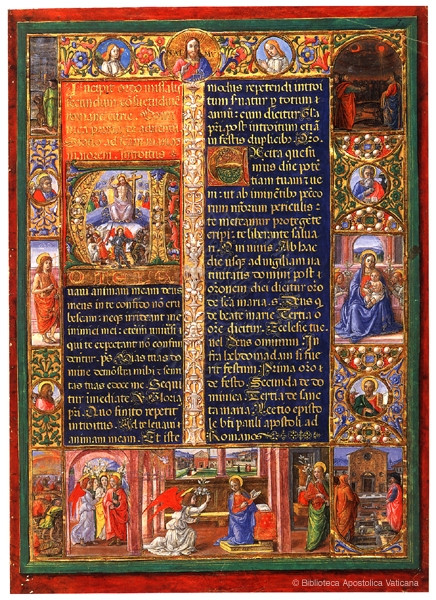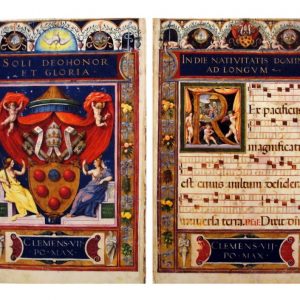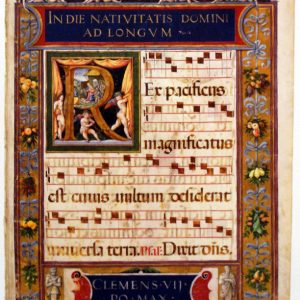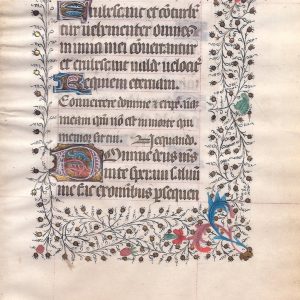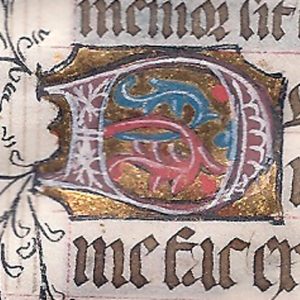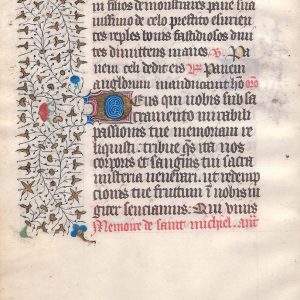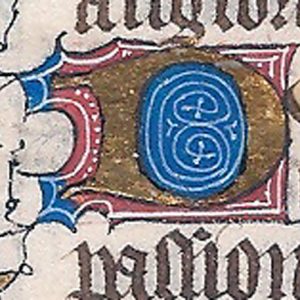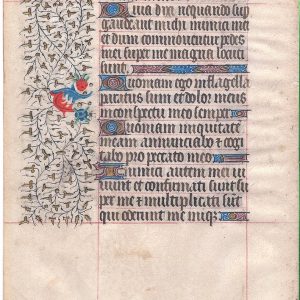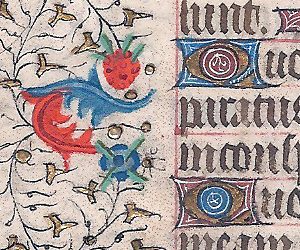What is an illuminated manuscript?
An illuminated manuscript is a book written and decorated by hand. Its
name is derived from the Latin manus meaning hand and scriptus
meaning writing. Manuscripts that were decorated with gold, silver or bright
paint are called illuminated, from the Latin illuminare meaning to
lighten or brighten up.
How were illuminated manuscripts made?
During the medieval period, books were written and decorated on parchment,
a type of animal skin. Most parchment came from cow skins that were prepared
through an elaborate process that involved soaking, scraping, drying and
treating the skins. The finest quality parchment, noted for its thin and
supple character, was called vellum. Once the necessary number of vellum
skins were prepared and cut to size for pages, they were then marked along
both margins with small pinholes. Using these holes as a guide, lines were
then inscribed or drawn on the page to establish the layout for the scribes
and decorators.
Following this, a calligrapher or scribe would write on the parchment with
a reed or feather quill pen. In the early Middle Ages, the best quills came
from several varieties of geese found off the coast or England. The scribe
used an ink derived either from carbon soot or gall nuts. In one method,
carbon soot from beeswax candles or linseed oil lamps was combined with gum
arabic to produce an indelible black ink. In the other, gall nuts, the
swollen nodules produced by certain insects living in oak trees, was mixed with
iron salts, making an ink which eventually turned brown from exposure to the
atmosphere.
While the main body to the text was usually written in black or brown ink,
colored lines of writing, called rubrics (from the Latin rubrica
meaning red), were most often, but not always, written in red. Rubrics served
as instructional guides to the reader, providing descriptive headings and
marking divisions in the text. Rather than write original works spontaneously
onto the page, medieval scribes, more often than not, copied their work from
model texts, called exemplars. When the text was completed, the manuscript
was decorated or illuminated in the blank spaces the scribe had intentionally
left for the illuminator.
How were illuminated manuscripts decorated?
The illuminator, who was a specialist distinct from the scribe, had a
repertoire of visual motifs that he or she employed to decorate the
manuscript according to the nature of the text and the expense of the
commission. Letters which began new chapters or important passages in the
book could be decorated or historiated. Decorated letters were embellished
with geometric, foliate, and zoomorphic designs, or with mixed elements of
all three. Historiated initials, deriving their name from the French ystoire,
served as frames that enclosed small figural or narrative scenes.
To further enliven the text, the margins of the page were often adorned
with decorated borders. Their decoration varied from small line drawings of a
whimsical character, known as “drolleries,” to elaborately painted
floral patterns filling the entire border. In some instances, small scenes
were incorporated into the border in the form of medallions called roundels
or rectangular panels in the lower margin known by their French term, bas de
page.
For more expensive commissions, paintings known as miniatures were often
included in the decorative program. Miniatures are named not for their small
size but from the Latin word minum, which is a red pigment used in
paint. Miniatures enhanced the beauty of the book with narrative and symbolic
scenes. Their functions ranged from illustrating the text and dividing the
book into sections, to serving as devotional icons and aids to study and
prayer. Within this context, a diverse range of regional and personal styles
developed; making each manuscript unique in both style and content.
The paint used to decorate manuscripts and paint miniatures came from a
variety of sources including oxidized metals as well as vegetable and animal
matter in a tempera base. Vermilion was made from mercury and sulfur, while
ultramarine blue, a pigment as expensive as gold, was made from crushing
lapis lazuli, a semi-precious stone imported from Afghanistan during the
Middle Ages. Materials were very expensive, and sometimes substitutes for
real gold were used.
What books were illuminated, where, and for whom?
Illuminated manuscripts exist in two categories; religious and secular.
The religious manuscripts consist of books used during the services of the
Roman Catholic Church and at home for personal devotion. Many of these
service books included music in the form of Gregorian chants with their
texts.
Click here to see an example of a Music Manuscript leaf.
In the early Middle Ages, lavish biblical manuscripts, called treasure
books, were richly illuminated in order to praise God, since they contained
God’s word. In the latter Middle Ages, deluxe personal prayer books, called
Books of Hours, were the expressions of wealth and social status, like
expensive jewelry and fine clothing. Secular manuscripts, books of
literature, on various topics such as hunting and politics, exist in far
fewer numbers than religious books, and consequently are often much more
expensive.
Before the thirteenth century, monks working in the scriptorium, or
writing room where books were made initially produced medieval manuscripts in
monasteries. More than five hundred monasteries existed in England alone by
the twelfth century, and a typical monastic library might possess over three
hundred books in its library. By the beginning of the thirteenth century, the
growth of towns and the establishment of universities in Paris, Oxford, and
Bologna led to the rise of secular scribes and artists who served students
and professors as well as the nobility.
Later in the fourteenth century a rise in literacy and the development of
an upper-middle class created a large demand for illuminated manuscripts. The
production of illuminated manuscripts of prayer books for personal devotions,
called Books of Hours, increased dramatically.
How do manuscripts acquire value?
Medieval and renaissance illuminated manuscripts have never been without
substantial value. Because of their striking beauty and great allure, many
have been considered treasures from the time of their creation to the present
day. In the inventories of kings and dukes who commissioned them, manuscripts
were listed among their most precious objects with great care. Many
illuminated manuscripts were made for or collected by the world’s most
powerful men and women, who possessed expensive and refined taste.
Almost ten centuries ago, lavishly illuminated biblical manuscripts or
treasure books were made for the Carolingian and Ottonian emperors of
Germany. These illuminated Gospels numbered among the most valuable items in
the imperial treasury, where they were stored and displayed with other
treasure to proclaim the wealth and status of the owner. It is no coincidence
that one such book, the Gospels of Henry the Lion, sold at Sotheby’s auction
house in 1983 for almost 12 million dollars – the highest price ever paid for
a work of art at the time.
Later generations of medieval royalty, especially in France, commissioned
and collected a variety of illuminated manuscripts. Among the greatest of
these medieval bibliophiles were Jean, Duke of Berry, and Charles the Bold,
Duke of Burgundy. The libraries they formed have become legendary, and their
contents now constitute the nucleus of many of the world’s greatest
institutions.
To the modern collector, illuminated manuscripts represent the finest
examples of Western painting from the medieval period Their jewel-like
quality inspires a passion which transcends time. Such noted figures as John
Pierpont Morgan, Collis Huntington, Henry Walters, Robert Lehman, and John Paul
Getty Jr. Have all avidly collected important medieval and renaissance
manuscripts and miniatures.
Today, manuscripts are collected in the form of complete books, known as
codexes, and as single leaves (individual pages) and cuttings (cut-out
portions of pages). High quality examples are uncommon and of considerable
value. The collecting of single leaves and cuttings dates back to at least
the eighteenth century when many miniatures were separated from their texts
to be appreciated and displayed independently as small works of art by
celebrated collectors of paintings and drawings. In England, an import tax on
books by weight encouraged the wholesale destruction of many large heavy
Italian manuscripts, from which the illuminated initials were cut.
Illuminated manuscripts retain significance today not only for their great
aesthetic appeal, but also for their depth as sophisticated cultural objects
which may be appreciated in a great variety of ways. As great drawings,
illuminated manuscripts represent some of the finest artistic production of
the medieval period in its original unrestored state. This is in contrast to
panel paintings of the same time that have often been heavily restored and
cost several orders of magnitude more than manuscripts. Even textual pieces
with minimal painting are highly valued as some of the best examples of the
waning art of calligraphy. Stories of the sale and purchase of great
manuscripts are among the most colorful and legendary in the history of the
world’s most renowned auction rooms.
Today, the supply of medieval and renaissance manuscripts is dwindling.
Dr. Christopher de Hamel, Director of Sotheby’s in London, estimates that
approximately fifty to seventy percent of the medieval and renaissance
manuscripts sold at public auction each year may never again be resold. It is
a fitting and final tribute to the universal appeal of manuscripts that the
highly refined aesthetic taste of the East, especially in Japan, has begun to
recognize the value of these western treasures, and its collectors have
aggressively entered the manuscript market.
|
